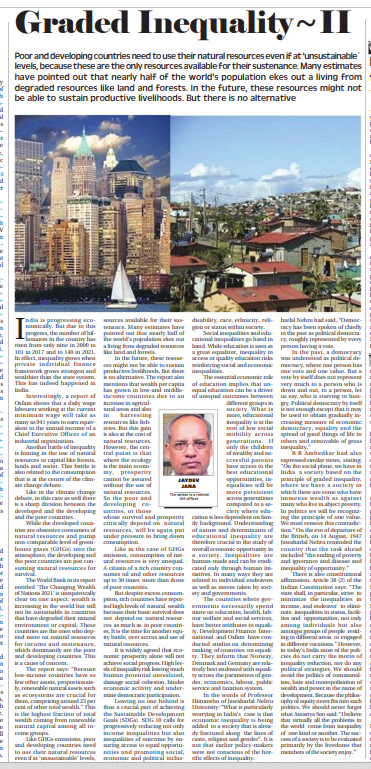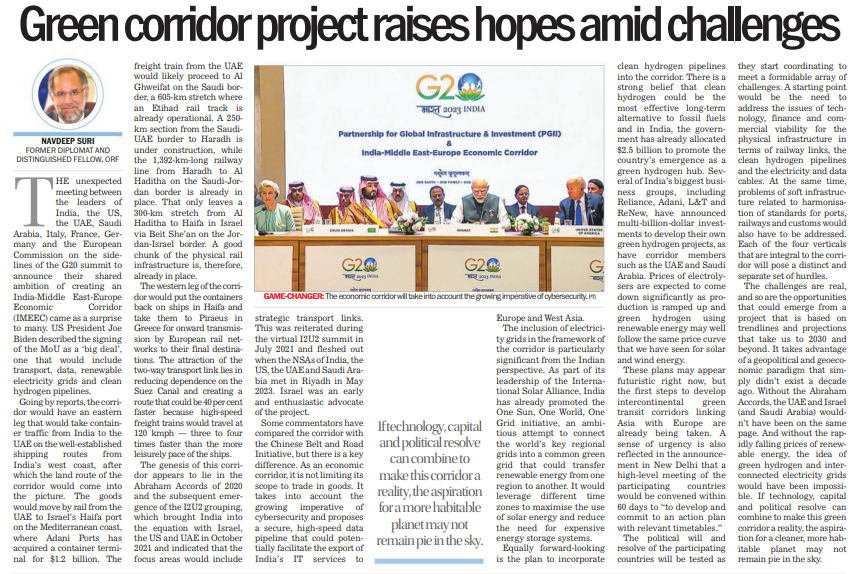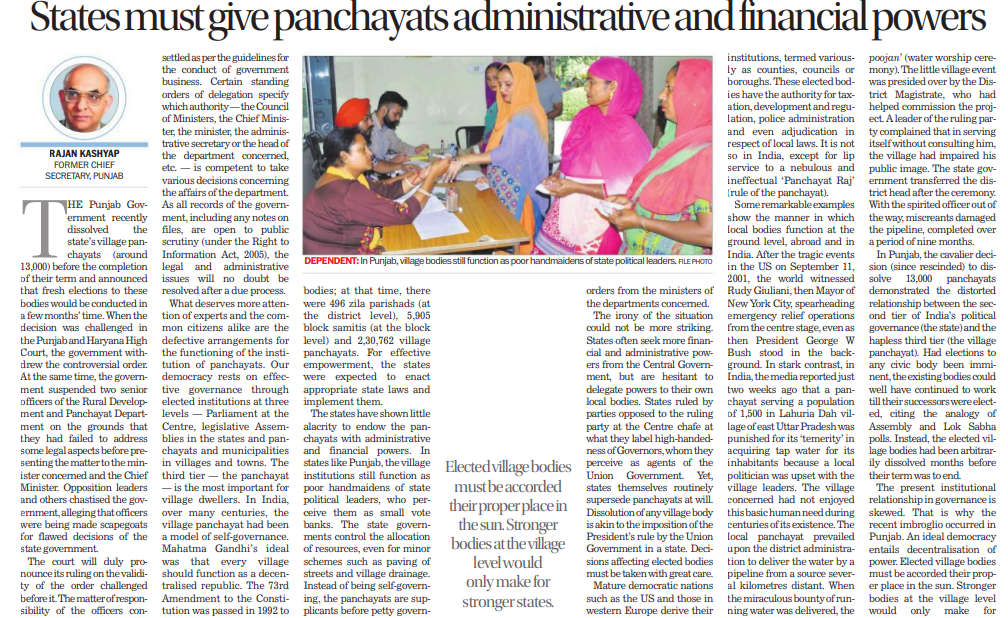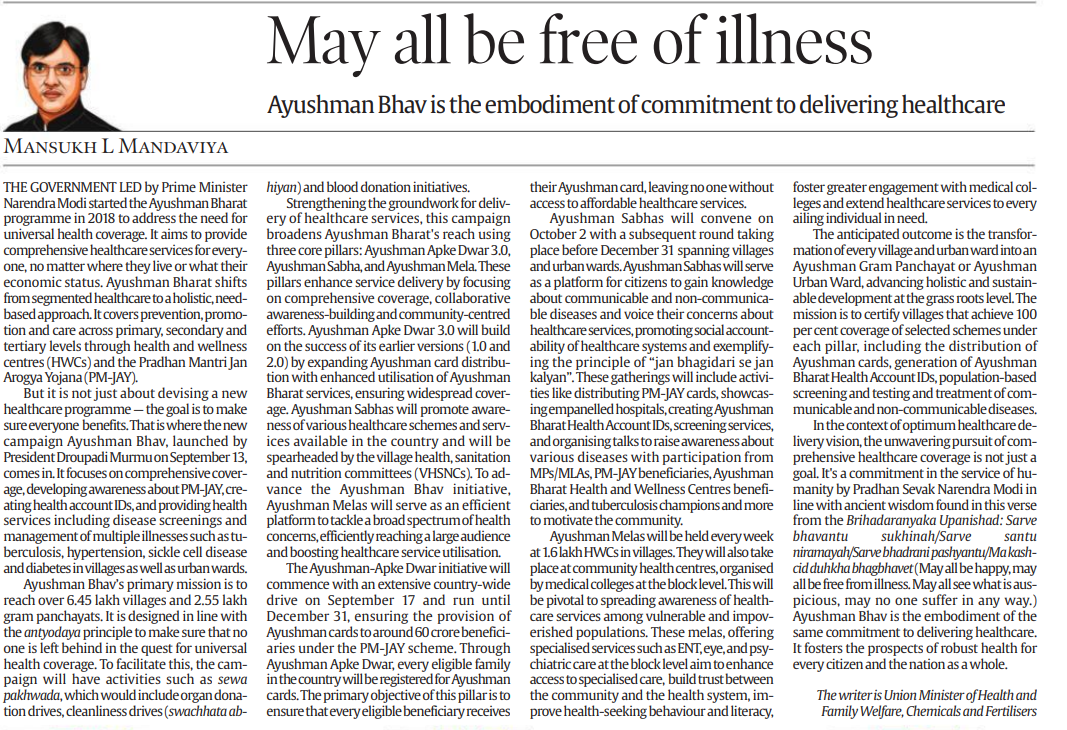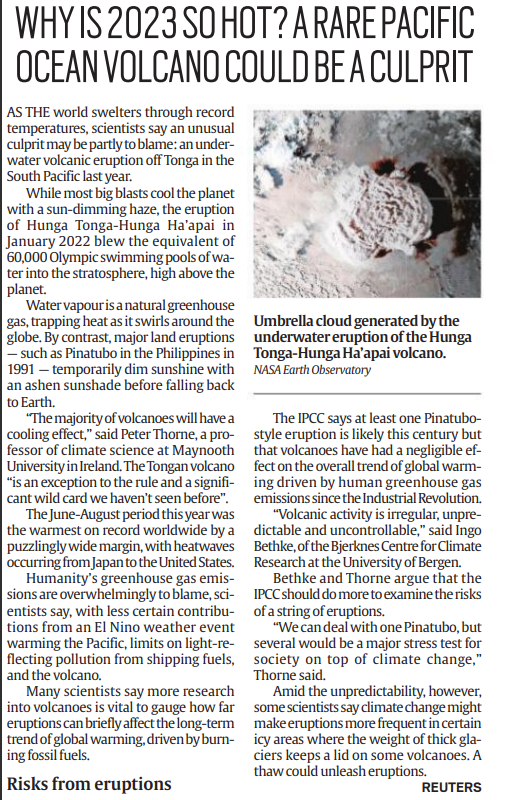Rising Economic Prosperity in India and Its Impact on Inequality
Introduction
- India has experienced significant economic progress in recent years, resulting in a substantial increase in the number of billionaires.
- However, this economic growth has led to a concerning rise in wealth inequality within the country.
Wealth Inequality
- The number of billionaires in India has surged from nine in 2000 to 140 in 2021.
- This dramatic increase in private wealth has exacerbated income inequality, as private individuals now possess more wealth than the state system itself.
- Oxfam’s report highlights the alarming disparity between the annual income of a daily wage laborer and that of a CEO, revealing a stark contrast that symbolizes income inequality in the country.
Natural Resource Disparities
- In addition to income inequality, disparities in the use of natural resources such as forests, land, and water are fueling another battle for equity.
- Developed countries exhibit excessive consumption and greenhouse gas emissions, while developing and poor nations rely on these resources for basic survival.
- The World Bank’s report underscores the risk of unsustainable resource use, especially in countries heavily dependent on natural assets.
The poor and developing countries, despite environmental concerns, have no alternative to using these resources for sustenance.
Education and Social Inequality
- Education, often considered a great equalizer, is entwined with social inequality.
- Unequal access to quality education reinforces social and economic disparities, hindering social mobility across generations.
- The study of educational inequality is crucial for assessing overall economic opportunities within a society.
- Addressing these inequalities requires a combination of individual efforts and government initiatives.
Government Spending and Equality
- Countries that allocate more resources to education, health, labor welfare, and social services tend to exhibit greater equality.
- Studies by Development Finance International and Oxfam rank Norway, Denmark, and Germany as countries relatively well-endowed with equality across various parameters.
- Government policies that focus on reducing inequality can play a significant role in creating a more equitable society.
Historical Perspective and Constitutional Mandate
- India’s historical leaders, including Jawaharlal Nehru and B.R. Ambedkar, recognized the need to combat poverty, inequality, and injustice.
- The Indian Constitution, in Article 38(2), mandates the state to minimize income inequalities and eliminate disparities in status, facilities, and opportunities.
- However, contemporary policies often prioritize other goals, leaving inequality unaddressed.
Some other forms of Disparities
Healthcare Disparities
- In India, disparities in healthcare access and outcomes represent another critical dimension of inequality.
- While the country has made significant strides in healthcare infrastructure, there remains a substantial gap between the quality of healthcare available to the affluent and that available to the underprivileged.
- The wealthy often have access to world-class medical facilities, while a significant portion of the population lacks access to even basic healthcare services.
- This healthcare inequality not only perpetuates health disparities but also deepens economic inequalities as medical expenses can push families into poverty.
Urban-Rural Divide
- The urban-rural divide in India is a persistent source of inequality. Rapid urbanization has brought economic opportunities to cities, but rural areas continue to lag behind in terms of infrastructure, education, healthcare, and employment opportunities.
- This disparity in development has led to significant migration from rural to urban areas in search of better livelihoods, further exacerbating inequalities and contributing to overcrowding and inadequate living conditions in urban centers.
Digital Divide
- In an increasingly digital world, access to technology and the internet plays a pivotal role in bridging economic gaps.
- The digital divide in India remains pronounced, with urban and affluent populations enjoying better access to digital resources and opportunities.
- This divide can hinder individuals in rural and economically disadvantaged areas from accessing online education, job opportunities, and government services, perpetuating existing disparities.
Caste-Based and Religious Inequities
- India has a long history of social inequalities based on caste and religion. Despite legal provisions aimed at eradicating caste discrimination, it continues to persist in various forms.
- Caste-based disparities in education, employment, and social standing remain a significant challenge.
- Similarly, communal tensions and religious disparities can lead to discrimination and unequal access to resources and opportunities, further fragmenting society.
Gender Inequality
- Gender inequality remains a pervasive issue in India, impacting women’s access to education, employment, and healthcare.
- Despite progress in women’s empowerment, gender-based violence, unequal pay, and limited opportunities for women in certain industries persist.
- Addressing gender inequality is essential for achieving overall social and economic equity.
Political Inequality
- Political power and influence can significantly impact the distribution of resources and opportunities.
- Political inequality, characterized by unequal representation and decision-making processes, can perpetuate economic disparities.
- Empowering marginalized groups and ensuring their active participation in the political process is crucial for addressing this dimension of inequality.
Conclusion
As India experiences economic growth, it must also address the pressing issue of inequality. Wealth, resource, and educational disparities pose substantial challenges to the country’s social fabric and economic progress.
Achieving the Sustainable Development Goals, particularly SDG 10, which focuses on reducing inequality, requires a concerted effort from both individuals and governments. In the pursuit of prosperity, India must prioritize equity, social justice, and the well-being of all its citizens, as articulated by its founding leaders and enshrined in its constitution.
The Emergence of the India-Middle East-Europe Economic Corridor (IMEEC)
Introduction
- The unexpected gathering of leaders from India, the US, the UAE, Saudi Arabia, Italy, France, Germany, and the European Commission at the G20 summit to announce the creation of the India-Middle East-Europe Economic Corridor (IMEEC) took many by surprise.
- US President Joe Biden emphasized the significance of this Memorandum of Understanding (MoU), highlighting its focus on transport, data, renewable electricity grids, and clean hydrogen pipelines.
The Corridor’s Eastern Leg
- Reports suggest that IMEEC will have an eastern leg, initially transporting container traffic from India to the UAE via established shipping routes along India’s west coast.
- Subsequently, the land route of the corridor will come into play. Goods will be transported by rail from the UAE to Israel’s Haifa port on the Mediterranean coast, where Adani Ports has invested $1.2 billion in a container terminal.
- The freight train from the UAE will likely proceed to Al Ghweifat on the Saudi border, utilizing an operational Etihad rail track.
- With sections under construction and already in place, a significant portion of the rail infrastructure is already available.
The Western Leg and Suez Canal Alternative
- The western leg of the corridor will involve shipping containers from Haifa to Piraeus in Greece. From there, European rail networks will take over, ensuring goods reach their final destinations.
- The allure of this two-way transport link lies in reducing dependence on the Suez Canal, potentially offering a route that is 40% faster thanks to high-speed freight trains traveling at 120 kmph, significantly faster than traditional shipping.
Genesis and Comparisons
- The origins of IMEEC appear to be rooted in the Abraham Accords of 2020 and the emergence of the I2U2 grouping in October 2021, which brought India into the equation with Israel, the US, and the UAE, emphasizing strategic transport links.
- While some have compared IMEEC to the Chinese Belt and Road Initiative, a key difference lies in IMEEC’s broader scope, encompassing not only goods trade but also cybersecurity and high-speed data pipelines, potentially facilitating India’s IT services export to Europe and West Asia.
Electricity Grids and Clean Hydrogen
- The inclusion of electricity grids is particularly significant from India’s perspective, aligning with India’s leadership in the International Solar Alliance and the One Sun, One World, One Grid initiative.
- IMEEC aims to create a common green grid that maximizes the use of solar energy and reduces reliance on energy storage systems.
- Clean hydrogen pipelines are also part of the plan, with a strong belief that clean hydrogen could be a long-term alternative to fossil fuels.
- Countries like India, the UAE, and Saudi Arabia are already making significant investments in green hydrogen projects.
Future Prospects and Challenges
- While these plans may appear futuristic, they are already taking initial steps towards developing intercontinental green transit corridors.
- A sense of urgency is evident as the participating countries commit to convening a high-level meeting within 60 days to develop an action plan.
- However, several challenges loom. Coordinating technology, finance, and commercial viability for the physical infrastructure, harmonizing standards for ports, railways, and customs, and addressing specific hurdles within each of the four integral verticals of the corridor are among the challenges that must be overcome.
Conclusion
The emergence of IMEEC is a testament to the changing geopolitical and geoeconomic landscape, with the Abraham Accords and falling renewable energy prices creating opportunities that were inconceivable a decade ago. If technology, capital, and political resolve align to make IMEEC a reality, it could usher in a greener, more sustainable planet, fulfilling the aspiration for a cleaner and more habitable world.
THE STATE OF PUNJAB'S DISSOLUTION OF VILLAGE PANCHAYATS AND ITS IMPLICATIONS
Introduction:
- The Punjab Government’s abrupt dissolution of approximately 13,000 village panchayats before the completion of their term, followed by its withdrawal of the controversial order amidst legal challenges, has raised significant questions about governance and decentralization in India.
Government’s Decision and Legal Challenge:
- The Punjab Government dissolved village panchayats prematurely and later withdrew the order when challenged in the Punjab and Haryana High Court.
- Two senior officers of the Rural Development and Panchayat Department were suspended in connection with this issue, further raising concerns about accountability.
Decentralization and Panchayats in India:
- India’s democratic structure relies on effective governance through elected institutions at three levels: Parliament at the Center, legislative assemblies in states, and panchayats and municipalities in villages and towns.
- The village panchayat, the third tier, is especially crucial for rural areas and has historical significance dating back centuries.
- The 73rd Amendment to the Constitution in 1992 aimed to empower these panchayats, but states have been slow in granting them administrative and financial powers.
Panchayats as Dependent Entities:
- In states like Punjab, village panchayats often function as instruments of state political leaders, serving as vote banks.
- The state government retains control over resource allocation for even minor local schemes, leaving panchayats beholden to government officials and ministers.
- This contradicts the idea of self-governance and decentralization.
Contradictory State Actions:
- States seek greater financial and administrative powers from the Central Government but are hesitant to delegate such powers to local bodies.
- This contradiction is similar to how states, especially those opposing the ruling party at the Center, criticize the role of Governors but readily supersede panchayats as they see fit.
Importance of Responsible Decisions:
Dissolving any elected body, including panchayats, should be done with caution, akin to the imposition of President’s rule in a state. Responsible decisions are vital in a mature democracy.
Global Comparisons:
- Mature democracies like the US and those in Western Europe derive strength from strong local institutions, such as counties and councils, with significant authority in taxation, development, regulation, and administration.
- In contrast, India’s “Panchayat Raj” remains mostly ineffectual.
Local Governance Case Study:
A contrasting example is seen in the response to crises. In the US, figures like Mayor Rudy Giuliani played pivotal roles in emergency relief operations, while in India, panchayats often face consequences for taking initiatives without consulting local politicians.
Conclusion:
The dissolution of 13,000 panchayats in Punjab highlights the skewed relationship between the state and the village panchayat, illustrating the need for decentralization of power.
Stronger local bodies are essential for a more robust and effective democratic system at the grassroots level, ultimately contributing to stronger states and a more inclusive governance structure.
Transforming Healthcare: Ayushman Bhav Campaign's Quest for Universal Health Coverage
Introduction:
- In 2018, Prime Minister Narendra Modi’s government initiated the Ayushman Bharat programme, a groundbreaking endeavor aimed at providing universal health coverage for all citizens, regardless of their location or economic status.
- The program represents a shift from segmented healthcare to a comprehensive, need-based approach, encompassing prevention, promotion, and care across primary, secondary, and tertiary levels.
Ayushman Bhav Campaign Overview:
- Launched on September 13 by President Droupadi Murmu, the Ayushman Bhav campaign is designed to ensure the inclusive success of the Ayushman Bharat program.
- This campaign focuses on various key aspects to achieve comprehensive coverage and improve healthcare services.
Objectives of Ayushman Bhav Campaign:
- Comprehensive Coverage: The campaign’s primary mission is to reach over 6.45 lakh villages and 2.55 lakh gram panchayats, ensuring that no one is left behind in the pursuit of universal health coverage.
- Awareness Building: Ayushman Bhav aims to create awareness about the Pradhan Mantri Jan Arogya Yojana (PM-JAY) and its benefits, emphasizing the importance of healthcare access.
- Health Account IDs: It seeks to establish health account IDs, facilitating efficient tracking and management of health records for individuals.
- Disease Screenings and Management: The campaign addresses multiple illnesses, including tuberculosis, hypertension, sickle cell disease, and diabetes, by providing disease screenings and management in both rural villages and urban wards.
Core Pillars of Ayushman Bhav Campaign:
- Ayushman Apke Dwar 3.0: Building on the success of its predecessors, this pillar aims to distribute Ayushman cards to approximately 60 crore beneficiaries under the PM-JAY scheme. Its primary objective is to ensure that every eligible family in the country is registered for Ayushman cards.
- Ayushman Sabhas: These gatherings, led by village health, sanitation, and nutrition committees (VHSNCs), promote awareness of healthcare schemes and services, enabling citizens to voice their concerns and engage with healthcare systems.
- Ayushman Melas: Held at health and wellness centers (HWCs) and community health centers, these weekly events offer specialized healthcare services such as ENT, eye, and psychiatric care, targeting vulnerable and impoverished populations.
Anticipated Outcomes:
- The campaign aims to transform every village and urban ward into an Ayushman Gram Panchayat or Ayushman Urban Ward, achieving holistic and sustainable development at the grassroots level.
- Villages achieving 100% coverage under each pillar will be certified, reflecting the successful distribution of Ayushman cards, generation of health account IDs, population-based screenings, and treatment of various diseases.
Conclusion:
Ayushman Bhav is a testament to Prime Minister Narendra Modi’s commitment to delivering healthcare to all citizens. It aligns with the ancient wisdom found in the Brihadaranyaka Upanishad, striving for the happiness, health, and well-being of every individual in the nation.
This campaign embodies the pursuit of robust health for both individuals and the entire nation, marking a significant step towards achieving universal health coverage in India.

